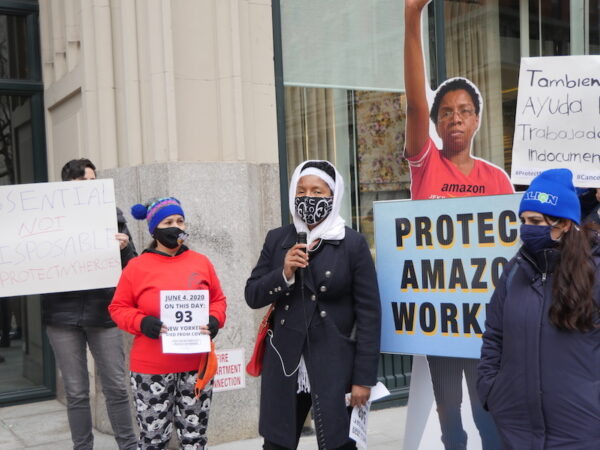
New York, NY – Covid-19 has killed more than 48,000 New Yorkers during the first year of the ongoing coronavirus pandemic. Rina Cummings, a 39 year-old flat sorter at the Amazon Fulfillment Center on Staten Island and mother of two, could have been one of them.
Cummings started working at the massive Amazon outlet just two months after it debuted in 2018. Rampant spread of the virus scared her so much that she stopped working in March of last year, and did not return again until this past July.
She calls the Staten Island site located on the west side of the borough between NY Route 440 and the Arthur Kill a “hot mess” where social distancing is virtually impossible and alarming text messages alerting employees about new infections in the workplace are routine.
“It was a disaster [last March], nobody was wearing masks,” Cummings recently told LaborPress during a protest held outside Amazon mogul Jeff Bezos’ multimillion dollar mansion at 212 Fifth Avenue. The somber event was meant to commemorate the tens of thousands of essential workers who have gotten sick and died — and to call on legislators to pass the NY HEREO Act.
The NY HERO Act seeks to codify enforceable workplace safety standards to protect the state’s 2.2 million essential workers who continue to toil on the front lines of the deadly and debilitating pandemic.
“Our people are still dying,” ALIGN Executive Director Maritza Silva-Farrell told the group of roughly 35 workers demonstrating outside Bezos’ palatial pad. “We need to protect workers and our community; we have to be responsible. That has to happen now — not tomorrow.”
A bipartisan group of New York State senators passed the Hero Act earlier this month, followed by the NYS Assembly Labor Committee.
Cummings, meanwhile, will only work weekends, pulling 10-hour shifts at the Staten Island facility starting at 7:15 a.m. She has 16-year-old daughter in high school preparing for college and a 3-year-old son at home — the grim possibility of infecting them with Covid-19 is an ever-present fear.
“People are getting sick and dying all across the Amazon network,” she said.
When asked, Amazon refused to say how many text messages it sent out to its Staten Island employees over the last few weeks, alerting them about new infections within the facilities.
Instead, company spokesperson Branden Baribeau sent an email in response to a request for comment saying, “Nothing’s more important than the health and safety of our employees, and we’re doing everything we can to support them through the pandemic.”
According to Amazon, they spent $11.5 billion on safety measures and equipment inside their facilities last year. That includes the distribution of more than 283 million face masks and the creation of hundreds of Covid-19 testing labs capable of conducting tens of thousands of tests a day.
But Cummings — whose weekend salary still only amounts to little more than $20 an hour after Amazon cut employee hazard pay back in June — said it can take three days for Amazon workers to get their test results back. During which time, infected employees can still be working.
Aisles inside the Staten Island facility are crowded and long lines are everywhere, according to Cummings. Lunch breaks require strategic planning. Spend too much “Time OFF Task [TOT]” and you can be terminated quick. And while Cummings says people of color represent at least half of the Staten Island facility’s workforce, few are in supervisory roles.
“Amazon shows what they want the press and the world to see — not what I see,” she said. “We need to take a hard look at how these billionaires can move into our neighborhoods and profit [off the backs of workers].”
The historic drive to unionize Amazon’s warehouse in Bessemer, Alabama will not only be revolutionary for Amazon employees working across the county — but essential workers everywhere.
“Can you imagine?” Cummings said. “It would be a great example. That’s all we need is one state and then we copy it. That gives us hope.”
As workers here await action on the NY HERO Act, Silver-Farrell wants everyone to remember where they were last year.
“Remember where you where a year ago; what were you thinking and who was delivering food for you; and who was there for you when you needed them the most — essential workers. Workers who continue to be excluded,” she said.



